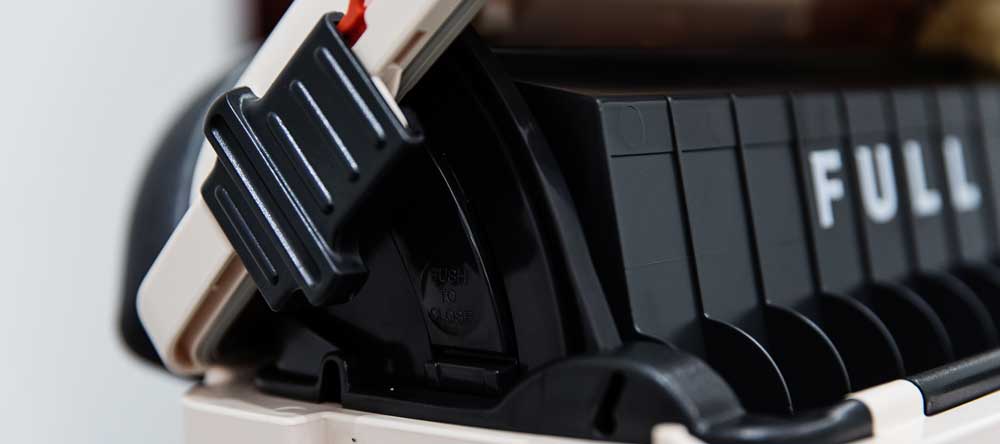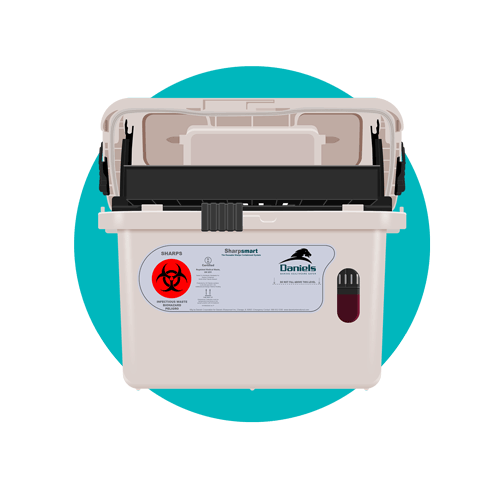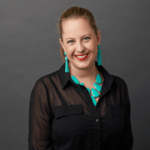Sharps Container Overfilling? No more!

One of the leading causes of sharps injuries is sharps container overfill. A sharps container, by nature of its intended use, should be designed through a process of safety engineering; a discipline assuring that the device provides an acceptable level of safety. Unfortunately in the United States today, very few sharps container solutions have been designed to that degree of safety.
Identified through multiple studies, the lack of an overfill-mechanism in sharps containers has been one of the highest contributors to container-associated needlestick injuries. In December 2015 OSHA cited Kaiser Foundation hospitals $149,000 for exposing their staff to injury and infection from used needles in the hospitals’ sharps containers.
At least three employees had been stuck by contaminated needles in the last two years trying to empty the containers which often overflowed and prevented the lid from closing properly.
The scenario of a sharps container being filled beyond its recommended capacity is not uncommon and is one that consistently puts patients and healthcare workers at risk.
The Sharpsmart is designed with overfill protection
Daniels Sharpsmart container is the only sharps container system in the world with a tray that self-locks when contents reach the fill level. It takes the human choice out of the equation; it protects healthcare workers that would, by nature, put patient needs ahead of their own safety, and it ensures that costs are managed at a facility level with sharps container capacity being fully realized without risk to users.
The Sharpsmart removes onus for safety on the user; catering to a wide spectrum of human behavior, the container does not require staff to constantly monitor fill-reach, and passively protects users 24 hours a day. The engineered design of the Sharpsmart ensures that a sharps container overflowing is an impossible scenario. Container-associated sharps injuries commonly account for 4-11% of total sharps injuries in the United States today. Extrapolating from a US study, it is estimated that 19,000 sharps injuries could be prevented in the US per year if such human-factor-engineered features were possible in all sharps containers.
It’s time to respect the impact that sharps container design has on safety
The importance of sharps container design has gone unheralded and unchallenged in the US industry for years. And we get it, in a high paced clinical environment, the importance of the question of ‘who replaces the sharps container when it is full’ is almost given the same weight as ‘who replaces the toilet roll’… and yields a uniquely similar answer – “someone else will do it.” It’s time to empassion all clinical workers to advocate for safer sharps containers! The sharpsmart ancipates human beavhior and prevents overfill altogether. The healthcare industry has tried to subvert the design flaws of sharps containers by enforcing a discipline of replacing containers before the contents reach the fill line. This practice incurs unnecessary costs to the facility with containers being replaced at partial-capacity, and while assisting in occupational risk prevention, simply does not eliminate human error. The Sharpsmart mitigates that human behaviors of ignoring the full sharps container and the avoidance of replacing it – actively protecting staff without expending any additional energy from them.
Healthcare needs a solution that does not offer safety as a choice – but demands it as a requirement
Our founder, Dan Daniels, was 22 years old when he first encountered clinical staff who had contracted HIV as a result of a needlestick injury. He spent two years analyzing needlestick injury data to identify every scenario where sharps container design could have played a factor in prevention, and interviewed countless clinicians to understand the workflow and environmental pressures that impact safety in a healthcare setting. One of the most prevalent causes of injuries was containers being overfilled, leaving healthcare workers susceptible to being stuck by exposed sharps. Dan’s conclusion to resolving this issue through safety engineering was simply… “Let’s not make overfilling an option.”
Don’t accept an overflowing sharps container to be an acceptable standard. For more information on the unique safety features of the Daniels Sharpsmart container, read more here.
Let's Talk!
Your time is valuable, and we don’t want to play hard to get. You can either phone us directly on the details listed on our contact page, or feel free to fill out this short form and one of our team members will get back to you as quickly as possible.
